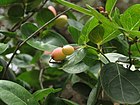Note: This is a project under development. The articles on this wiki are just being initiated and broadly incomplete. You can Help creating new pages.
Difference between revisions of "Carissa carandas"
| Line 2: | Line 2: | ||
'''Karanda''' is a climbing shrub or small tree. It grows upto 3 - 5 metres tall. The stems are armed with simple or branched, sharp spines. Very attractive when in fruit, the plant is often grown in the garden both as an ornamental and for its fruit in tropical and subtropical areas. It is not usually grown commercially. | '''Karanda''' is a climbing shrub or small tree. It grows upto 3 - 5 metres tall. The stems are armed with simple or branched, sharp spines. Very attractive when in fruit, the plant is often grown in the garden both as an ornamental and for its fruit in tropical and subtropical areas. It is not usually grown commercially. | ||
==Uses== | ==Uses== | ||
| − | {{Uses|}}, {{Uses|}}, {{Uses|}}, {{Uses| | + | {{Uses|Fever}}, {{Uses|Diarrhoea}}, {{Uses|Earache}}, {{Uses|Itches}}. |
==Parts Used== | ==Parts Used== | ||
| − | {{Parts Used| | + | {{Parts Used|Fruit}}. |
==Chemical Composition== | ==Chemical Composition== | ||
| − | <ref name="chemical composition"/> | + | The preliminary phytochemical studies were performed by using petroleum ether and methanol extract of dried fruits of Carissa carandas to screen the presence of various secondary metabolites.<ref name="chemical composition"/> |
==Common names== | ==Common names== | ||
| Line 17: | Line 17: | ||
===Dravya=== | ===Dravya=== | ||
===Rasa=== | ===Rasa=== | ||
| − | |||
===Guna=== | ===Guna=== | ||
| Line 30: | Line 29: | ||
==Habit== | ==Habit== | ||
| − | {{Habit|}} | + | {{Habit|Shrub}} |
==Identification== | ==Identification== | ||
| Line 49: | Line 48: | ||
==Mode of Propagation== | ==Mode of Propagation== | ||
| − | {{Propagation|}} | + | {{Propagation|Seeds}}, {{Propagation|Cuttings}}. |
==How to plant/cultivate== | ==How to plant/cultivate== | ||
| − | <ref name="How to plant/cultivate"/> | + | A plant of subtropical to tropical areas, where it is found at elevations up to metres.<ref name="How to plant/cultivate"/> |
==Commonly seen growing in areas== | ==Commonly seen growing in areas== | ||
| − | {{Commonly seen|}}, {{Commonly seen| | + | {{Commonly seen|Dry places}}, {{Commonly seen|Sunny places}}. |
==Photo Gallery== | ==Photo Gallery== | ||
| Line 68: | Line 67: | ||
<references> | <references> | ||
| − | <ref name="chemical composition">[ | + | <ref name="chemical composition">[https://www.hindawi.com/journals/bmri/2014/512369/ Chemical constituents]</ref> |
<ref name="Leaf">["morphology"]</ref> | <ref name="Leaf">["morphology"]</ref> | ||
| − | <ref name="How to plant/cultivate">[ | + | <ref name="How to plant/cultivate">[http://tropical.theferns.info/viewtropical.php?id=Carissa+carandas Cultivation]</ref> |
</references> | </references> | ||
Revision as of 15:00, 9 April 2020
Karanda is a climbing shrub or small tree. It grows upto 3 - 5 metres tall. The stems are armed with simple or branched, sharp spines. Very attractive when in fruit, the plant is often grown in the garden both as an ornamental and for its fruit in tropical and subtropical areas. It is not usually grown commercially.
Contents
- 1 Uses
- 2 Parts Used
- 3 Chemical Composition
- 4 Common names
- 5 Properties
- 6 Habit
- 7 Identification
- 8 List of Ayurvedic medicine in which the herb is used
- 9 Where to get the saplings
- 10 Mode of Propagation
- 11 How to plant/cultivate
- 12 Commonly seen growing in areas
- 13 Photo Gallery
- 14 References
- 15 External Links
Uses
Fever, Diarrhoea, Earache, Itches.
Parts Used
Chemical Composition
The preliminary phytochemical studies were performed by using petroleum ether and methanol extract of dried fruits of Carissa carandas to screen the presence of various secondary metabolites.[1]
Common names
| Language | Common name |
|---|---|
| Kannada | |
| Hindi | |
| Malayalam | |
| Tamil | |
| Telugu | |
| Marathi | |
| Gujarathi | |
| Punjabi | |
| Kashmiri | |
| Sanskrit | |
| English |
Properties
Reference: Dravya - Substance, Rasa - Taste, Guna - Qualities, Veerya - Potency, Vipaka - Post-digesion effect, Karma - Pharmacological activity, Prabhava - Therepeutics.
Dravya
Rasa
Guna
Veerya
Vipaka
Karma
Prabhava
Habit
Identification
Leaf
| Kind | Shape | Feature |
|---|---|---|
Flower
| Type | Size | Color and composition | Stamen | More information |
|---|---|---|---|---|
| {{{5}}} |
Fruit
| Type | Size | Mass | Appearance | Seeds | More information |
|---|---|---|---|---|---|
Other features
List of Ayurvedic medicine in which the herb is used
Where to get the saplings
Mode of Propagation
How to plant/cultivate
A plant of subtropical to tropical areas, where it is found at elevations up to metres.[3]
Commonly seen growing in areas
Photo Gallery
References
- ↑ Chemical constituents
- ↑ ["morphology"]
- ↑ Cultivation
External Links
- [ ]
- [ ]
- [ ]
- Ayurvedic Herbs known to be helpful to treat Fever
- Ayurvedic Herbs known to be helpful to treat Diarrhoea
- Ayurvedic Herbs known to be helpful to treat Earache
- Ayurvedic Herbs known to be helpful to treat Itches
- Herbs with Fruit used in medicine
- Habit - Shrub
- Index of Plants which can be propagated by Seeds
- Index of Plants which can be propagated by Cuttings
- Herbs that are commonly seen in the region of Dry places
- Herbs that are commonly seen in the region of Sunny places
- Herbs
- Pages without herbs images




